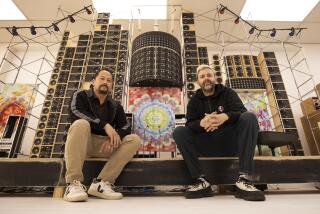Radio Collector Stays Tuned In to Past : Entertainment: He has about 2,000 varieties, many of which he bought for pennies. Many are on display at San Francisco exhibit.
SAN FRANCISCO — In the 1960s, Dan Healy spent a quarter on something most people would consider a hunk of junk.
Today, he says, it’s worth thousands of dollars.
Healy didn’t buy baseball cards or coins and it wasn’t really an investment at all. He bought old radios for a quarter each. His motivation was pure love.
“Radio was such an important part of my childhood,” said Healy, 47, who grew up in Weott in rural Humboldt County, on the northern edge of California.
“There was no television and only long-distance AM radio at night,” he said, recalling those days when the airwaves were ruled by the Lone Ranger, Charlie McCarthy, Jack Benny and the like.
Healy, now a sound man with the Grateful Dead, has amassed about 2,000 radios in a collection that “just keeps growing.”
About 400 of his radios are being exhibited in plexiglass cases along a corridor at San Francisco International Airport.
The display is complemented by other memorabilia relating to the golden days of radio.
Photos of Nat (King) Cole, Edward R. Murrow, Baby Snooks and other stars look down on the scores of sets made between 1919 and 1960.
The “Old Time Radio” exhibit even has a mock living room, circa the 1930s, dominated by an upright set broadcasting recordings of old shows. Another display, of an early radio studio, greets visitors.
But it’s the radios that steal the show.
In the heyday of radio, households clustered around the set, which was usually carved or otherwise decorated to be pleasing to the eye, unlike utilitarian models popular today.
The radios in the exhibit document the design and styling of the radio from the classic wooden cathedral radio to stately consoles to newer plastic and novelty models.
In the early days of the 1920s, tuning in must have been work.
The huge Adler-Royal Neutrodyne radio in the show has three dials, a wave control, a tone control and three plugs for the external horn speaker. The plugs are marked soft, medium and loud.
“Not very user friendly,” said Healy.
Healy said he started the collection when transistors replaced tubes and radios began to shrink.
“People were tossing the tube radios out and I could go to thrift stores and fill up my car with them for 25 cents,” he said. “Some of those radios are now selling for over $1,000.”
The radios have entered the world of the antique, he said with a trace of sadness.
“But there are still some guys, like myself, who view collecting radios as a spiritual experience.”
More to Read
The biggest entertainment stories
Get our big stories about Hollywood, film, television, music, arts, culture and more right in your inbox as soon as they publish.
You may occasionally receive promotional content from the Los Angeles Times.










